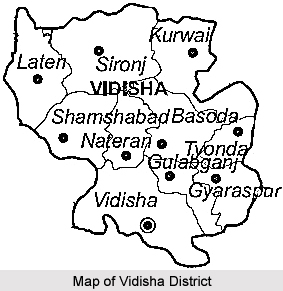 Geography of Vidisha district is vast and it covers a large area in the state of Madhya Pradesh in India. This district is located in between twenty three degree twenty one minutes to the North latitude and seventy seven degree fifteen minutes and seventy eight degree eighteen minutes to the East longitude. The district of Vidisha is situated in the eastern parts of the fertile Malwa Region. The shape of this district in the state of Madhya Pradesh is more or less elliptical and the longer axis lies from North-West to South-East with slight projections on the North, North-West, South and South-West. Its greatest length from North-West to South-East is about 133.6 kilometers and the greatest width from North-East to South-West is about ninety six kilometers. The Tropic of Cancer passes through the Southern stretch of this district which is about two kilometers to the south of the district headquarters. The Vidisha district is bounded in the North by the Guna district in the South by Raisen district and in the East by Sagar district. The total area over which it is spread is about seven thousand three hundred and seventy one square kilometers. The climate of the district of Vidisha is generally dry except during the South-West monsoon season.
Geography of Vidisha district is vast and it covers a large area in the state of Madhya Pradesh in India. This district is located in between twenty three degree twenty one minutes to the North latitude and seventy seven degree fifteen minutes and seventy eight degree eighteen minutes to the East longitude. The district of Vidisha is situated in the eastern parts of the fertile Malwa Region. The shape of this district in the state of Madhya Pradesh is more or less elliptical and the longer axis lies from North-West to South-East with slight projections on the North, North-West, South and South-West. Its greatest length from North-West to South-East is about 133.6 kilometers and the greatest width from North-East to South-West is about ninety six kilometers. The Tropic of Cancer passes through the Southern stretch of this district which is about two kilometers to the south of the district headquarters. The Vidisha district is bounded in the North by the Guna district in the South by Raisen district and in the East by Sagar district. The total area over which it is spread is about seven thousand three hundred and seventy one square kilometers. The climate of the district of Vidisha is generally dry except during the South-West monsoon season.
The various geological formations occurring in the Vidisha district are Alluvium, Laterite and Deccan Trap with inter-trapped beds. Alluvium occurs over a large part of the area mainly along the course of streams like Betwa, Sagar, Besh, etc. It consists primarily of yellow or grey brown sandy clay and possesses a large proportion of `Kankers`. Along the Betwa River it often forms steep cliffs in the Northern part of the area. Laterite occurs in some places as caps on some high trap hills, but usually as ferruginous cellular rocks capping low lying Deccan trap hills, in places surrounded by alluvium. These are used mainly as a road metal. The Deccan Trap is the most widespread rock formation in this district of the Madhya Pradesh state. These rocks are horizontal or nearly horizontal; the dark lava flows lend to the countryside a terraced appearance. The principal rock is basalt possessing vesicles filled with zeolite, agate, calcite, etc. The inter- trappeans, mainly impure crystalline limestone and cacareous chert occur as a residual blocks and boulders scatters over a surface as well as discontinuous outcrops amidst the Deccan Trap. Small isolated outcrops of intertrappeans mostly lime stone are also present in Vidisha.
The climate here is generally dry. The nights are generally pleasant and justify the praise by the Mughals for a Shab-E-Malwa famous throughout India. The monsoon comes during the month of June and continues till the end of September. The year may be divided into four seasons. The cold season starts from the month of December and ends in February and is followed by the hot summer season till mid-June. The period from mid-June to about the end of September experiences the South-West monsoon. The month of October and November may be termed the post-monsoon or retreating monsoon. The average annual rainfall received by this district 1,229.9 millimeter. During the summer season on individual days the maximum temperature goes above forty six degree Celsius. After the month of October, both the day and night temperatures steadily decreases till January which is the coldest month. The district is affected by cold waves during the cold season in association with the western disturbances passing across the northern part on India and the minimum temperature may drop down occasionally to a degree or so above the freezing point of water and frosts may occur.



















